name: title class: title, middle ## Global visual salience of competing stimuli .bigger[Alex Hernández-García (he/él)] Ricardo Ramos Gameiro & Alessandro Grillini & Peter König .gray224[European Conference on Visual Perception (ECVP) 2021 · The Internet · August 25th 2021] .center[ <a href="https://mila.quebec/"><img src="../assets/images/slides/logos/mila-beige.png" alt="Mila" style="height: 4em"></a> <a href="https://www.uni-osnabrueck.de/"><img src="../assets/images/slides/logos/uni-osnabrueck.png" alt="Universität Osnabrück" style="height: 4em"></a> <img src="../assets/images/slides/logos/eu.png" alt="European Union" style="height: 4em"> <a href="https://www.nextgenvis.eu/"><img src="../assets/images/slides/logos/ngv.png" alt="NextGenVis" style="height: 4em"></a> ] .footer[[alexhernandezgarcia.github.io](https://alexhernandezgarcia.github.io/) | [alex.hernandez-garcia@mila.quebec](mailto:alex.hernandez-garcia@mila.quebec) | [@alexhdezgcia](https://twitter.com/alexhdezgcia)] [](https://twitter.com/alexhdezgcia) --- ## Motivation .context[Ultimate underlying goal: understanding visual attention] .center[Accurate computational models of visual salience are already available .cite[(Kümmerer et al. 2016)]] .center[] .references[Kümmerer et al. [DeepGaze II: Reading fixations from deep features trained on object recognition](https://arxiv.org/abs/1610.01563). arXiv 1610.01563, 2016] --- count: false ## Motivation .context[Ultimate underlying goal: understanding visual attention] .center[Accurate computational models of visual salience are already available .cite[(Kümmerer et al. 2016)]] .center[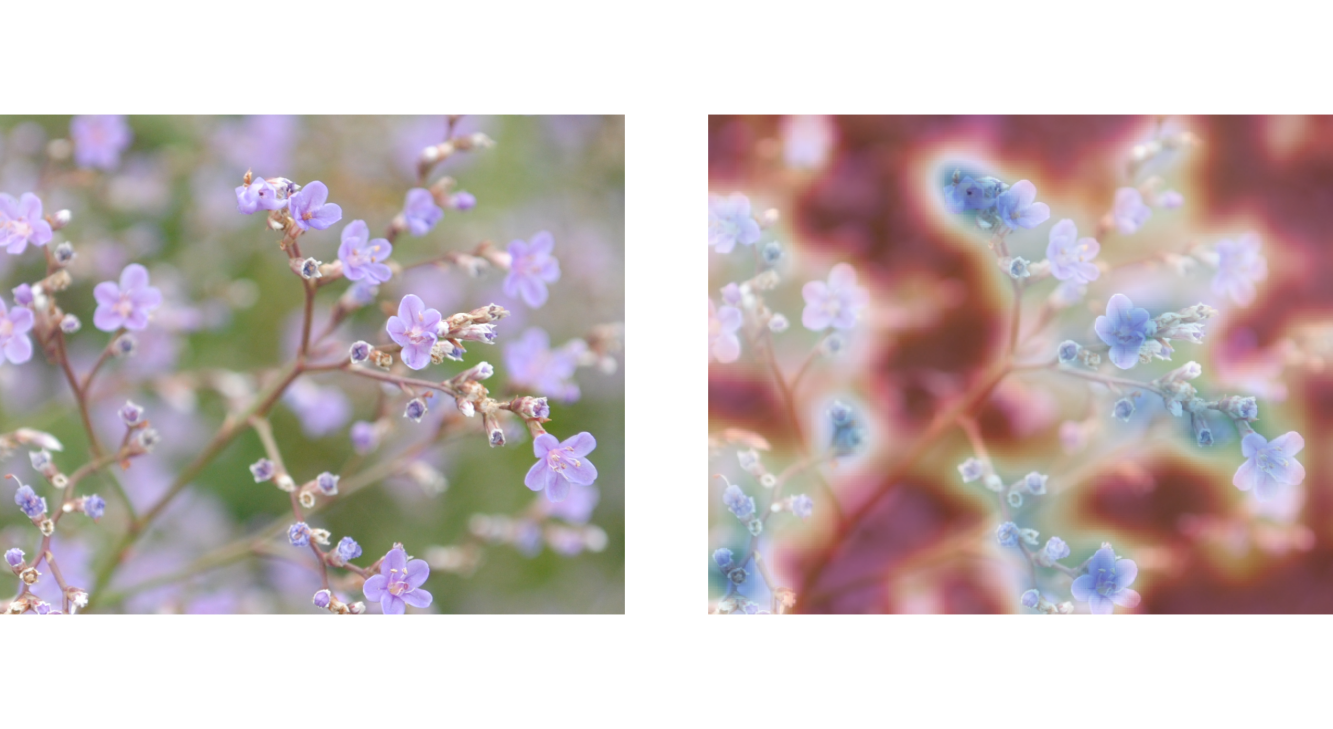] .references[Kümmerer et al. [DeepGaze II: Reading fixations from deep features trained on object recognition](https://arxiv.org/abs/1610.01563). arXiv 1610.01563, 2016] --- ## Motivation .context[Ultimate underlying goal: understanding visual attention] .center[Accurate computational models of visual salience are already available .cite[(Kümmerer et al. 2016)]] .center[] .references[Kümmerer et al. [DeepGaze II: Reading fixations from deep features trained on object recognition](https://arxiv.org/abs/1610.01563). arXiv 1610.01563, 2016] --- count: false ## Motivation .context[Ultimate underlying goal: understanding visual attention] .center[Accurate computational models of visual salience are already available .cite[(Kümmerer et al. 2016)]] .center[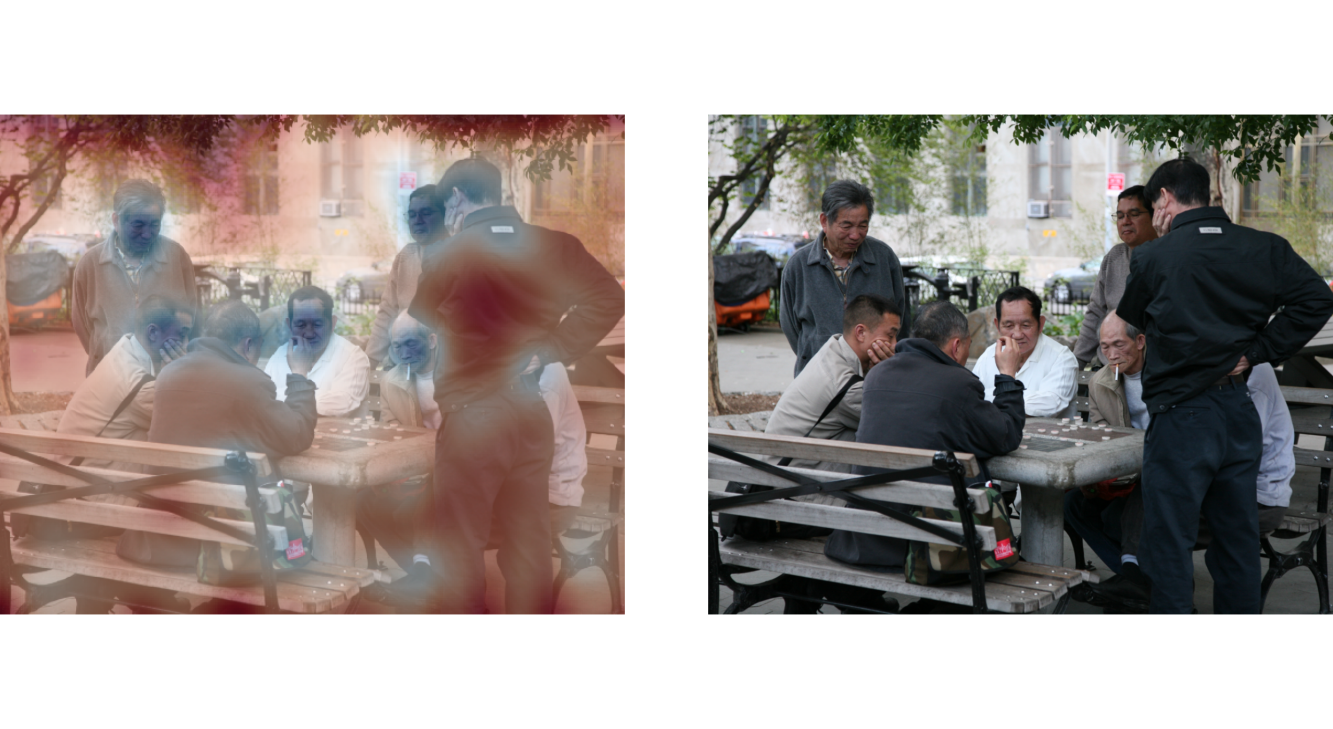] .references[Kümmerer et al. [DeepGaze II: Reading fixations from deep features trained on object recognition](https://arxiv.org/abs/1610.01563). arXiv 1610.01563, 2016] --- count: false ## Motivation .context[Ultimate underlying goal: understanding visual attention] .center[What if several images _compete_ for our visual attention?] .center[] --- count: false ## Motivation .context[Ultimate underlying goal: understanding visual attention] .center[Are some images, as a whole, more likely to attract human visual attention?] .center[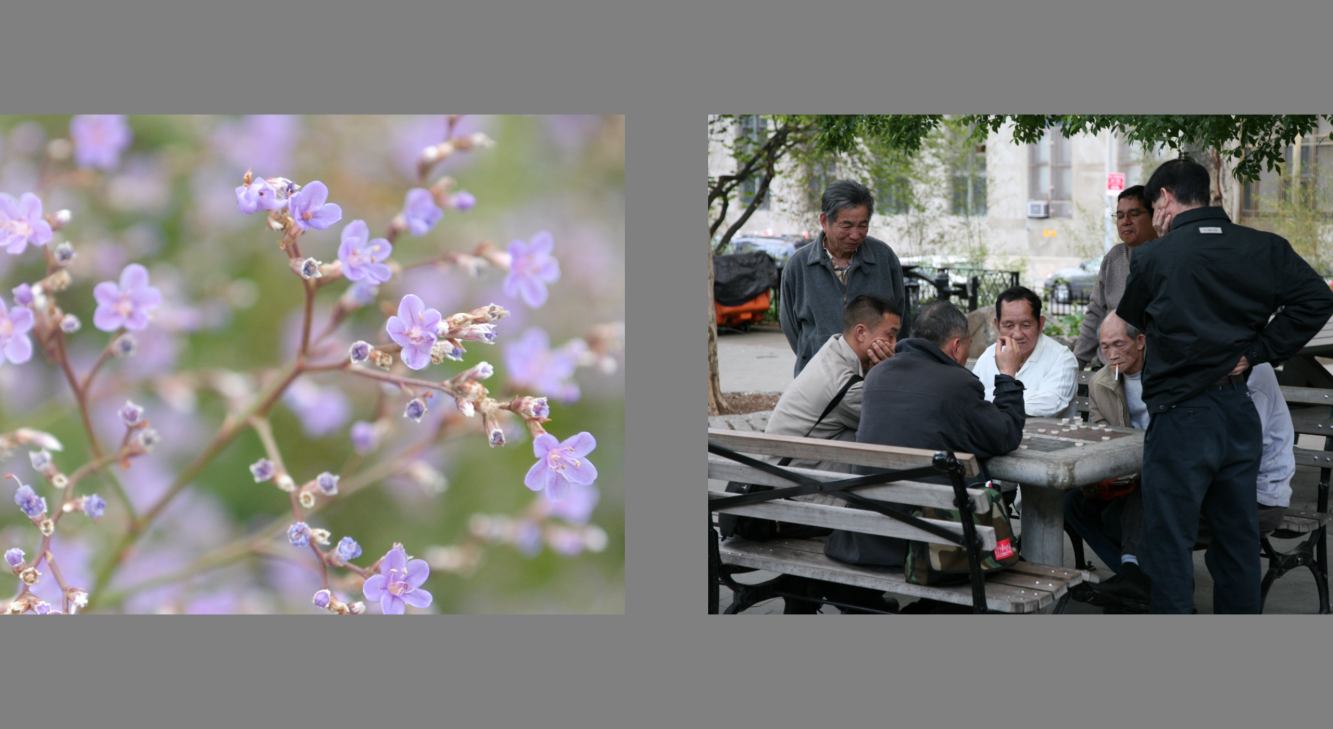] --- count: false ## Motivation .context[Ultimate underlying goal: understanding visual attention] .center[_Global Visual Salience_] .center[] --- ## Outline ### And main findings - spoiler! <img src="../assets/images/slides/misc/spoiler_alert.png" alt="Spoiler Alert!" style="height: 6em; rotate: 15deg; position: absolute; right: 1em; top: 2em"> -- 1. [Data collection (eye tracking)](#datacollection) -- 2. [Computational model](#computationalmodel) -- 3. [Results](#results) * a. It is possible to measure the global salience of natural images * b. The global salience of images cannot be explained by their local salience properties * c. There is a strong spatial bias towards the left side * d. Task and familiarity with one image do not influence the first fixation * e. Images with larger global salience are explored for longer time --- name: datacollection ## Data collection ### An eye-tracking experiment * 200 images * 6 categories * 49 participants * 200 trials per participant * 3 seconds per trial * Record first fixation after stimulus onset <img src="../assets/images/slides/globsal/experiment.gif" alt="Experiment GIF" style="height: 15em; position: absolute; right: 2em; top: 2em"> <img src="../assets/images/slides/globsal/experiment_scheme.png" alt="Experiment scheme" style="width: 85%; position: absolute; bottom: 2em"> --- name: computationalmodel ## Computational model ### Logistic regression .context[Can we learn a model of the behavioural visual responses?] **Goal**: predict the location of the .highlight1[first fixation] (left or right) given a pair of images from the data. -- #### Logistic regression for pairwise comparisons * $u$: image on the left * $v$: image on the right -- $$ h_w(u,v) = p(u > v) = \frac{e^{w_u}}{e^{w_u} + e^{w_v}} = \frac{e^{w_u - w_v}}{1 - e^{w_u - w_v}} $$ -- .conclusion[If the model fits the data, each learnt coefficient $w_i$ should reflect the likelihood that image $i$ is fixated first.] --- ## Computational model ### Design matrix .context[We want to model the location of the first fixation via logistic regression.] We have a data set of 49 participants $\times$ 200 trials ($N=9800$), where we know which two images of $M=200$ were presented, $x_u$ and $x_v$, and which image was fixated first. <img src="../assets/images/slides/globsal/logreg_designmat_nobias.png" alt="Design matrix, no bias" style="height: 10em"> --- count: false ## Computational model ### Design matrix .context[We want to model the location of the first fixation via logistic regression.] We have a data set of 49 participants $\times$ 200 trials ($N=9800$), where we know which two images of $M=200$ were presented, $x_u$ and $x_v$, and which image was fixated first. <img src="../assets/images/slides/globsal/logreg_designmat_bias.png" alt="Design matrix, bias" style="height: 10em"> * $t$: task * $f$: _familiarity_ * $s$: subject ($K=49$) --- ## Computational model ### Validation results .context[Logistic regression model trained to predict the location of the first fixation given two images.] .center[] .conclusion[Since the model successfully learnt the behavioural patterns from the experimental data with very low overfitting and low variance, the learnt coefficients can be meaningfully used for further analysis.] --- name: results ## Results ### a. Global salience of natural images .context[The model learnt one coafficient for each image, which can be interpreted as its **global salience**.] .center[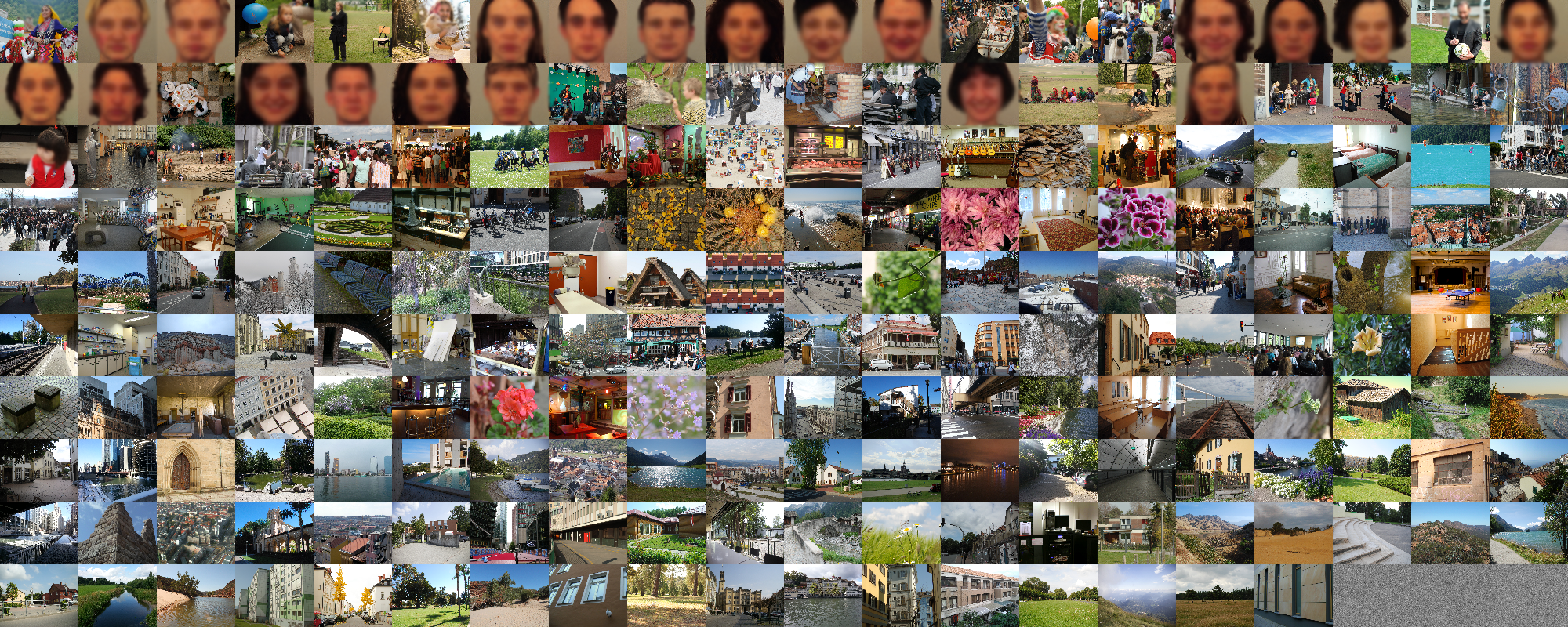] --- count: false ## Results ### a. Global salience of natural images .context[The model learnt one coafficient for each image, which can be interpreted as its **global salience**.] .center[] .conclusion[Images with faces or social content are more likely to attract the first fixation.] --- name: results ## Results ### b. Global vs. local salience .context[Are our global salience results explained by the local salience properties of the images?] -- We test 2 computational salience models: * GBVS: based on low-level descriptors .cite[(Harel et al. 2007)] * Deep Gaze II: high-level descriptors from a deep neural network .cite[(Kümmerer et al. 2016)] .references[ * Harel et al. [Graph-based visual saliency](https://papers.nips.cc/paper/2006/file/4db0f8b0fc895da263fd77fc8aecabe4-Paper.pdf). NeurIPS, 2007 * Kümmerer et al. [DeepGaze II: Reading fixations from deep features trained on object recognition](https://arxiv.org/abs/1610.01563). arXiv 1610.01563, 2016 ] -- We perform 2 types of analysis: * Predictivity of salience maps for the _location of the first fixation_ * Predictivity of salience maps for the _global salience scores_ --- ## Results ### b. Global vs. local salience .context35[Predictivity of salience maps for the _location of the first fixation_.] -- KL divergence between the distribution of first fixations and .highlight1[GBVS] salience map: $$ D_{KL}(F_j||S_j) = \sum_b F_j(b) \log \left(\frac{F_j(b)}{S_j(b)+\epsilon}+\epsilon \right) $$ -- .center[] --- count: false ## Results ### b. Global vs. local salience .context35[Predictivity of salience maps for the _location of the first fixation_.] KL divergence between the distribution of first fixations and .highlight1[GBVS] salience map: $$ D_{KL}(F_j||S_j) = \sum_b F_j(b) \log \left(\frac{F_j(b)}{S_j(b)+\epsilon}+\epsilon \right) $$ .center[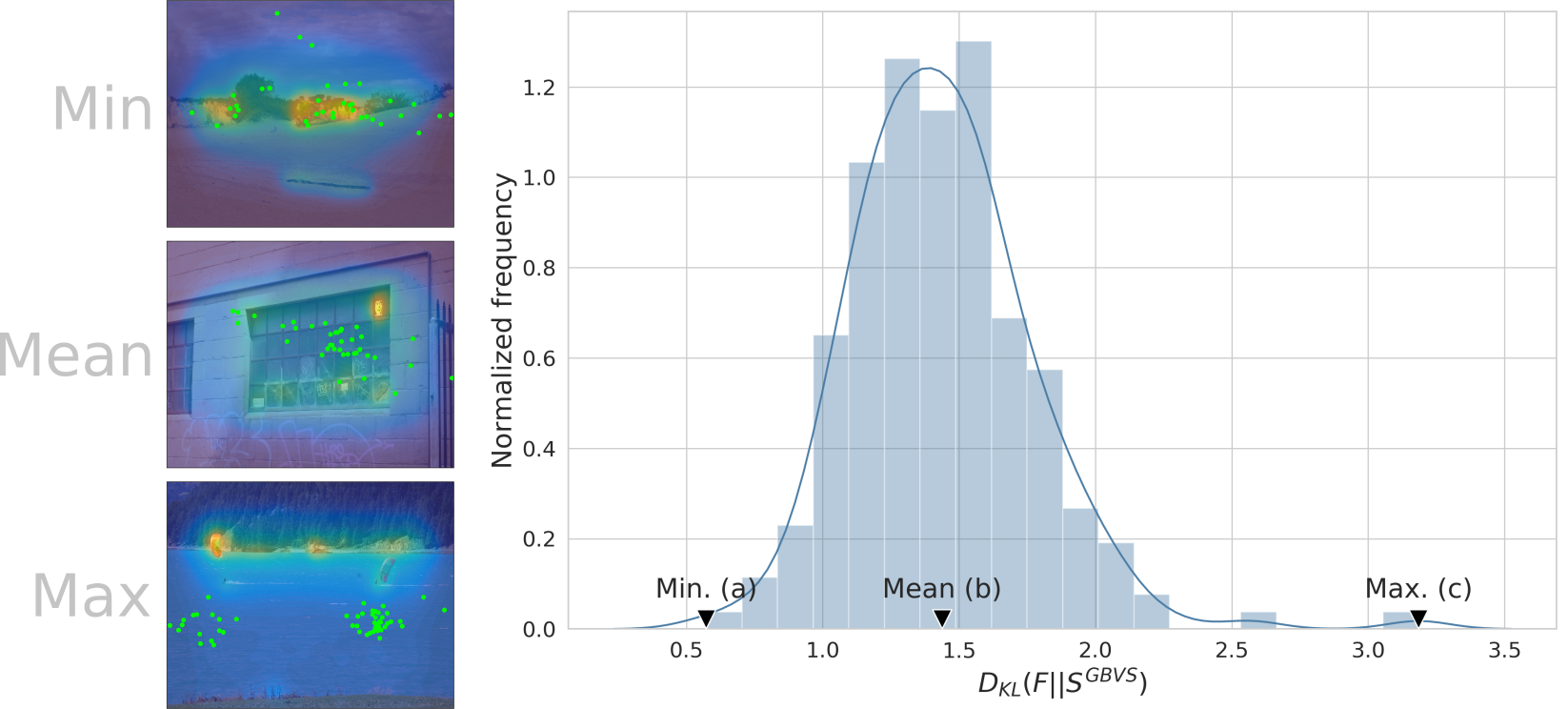] --- count: false ## Results ### b. Global vs. local salience .context35[Predictivity of salience maps for the _location of the first fixation_.] KL divergence between the distribution of first fixations and .highlight1[Deep Gaze II] salience map: $$ D_{KL}(F_j||S_j) = \sum_b F_j(b) \log \left(\frac{F_j(b)}{S_j(b)+\epsilon}+\epsilon \right) $$ .center[] --- count: false ## Results ### b. Global vs. local salience .context35[Predictivity of salience maps for the _location of the first fixation_.] KL divergence between the distribution of first fixations and .highlight1[Deep Gaze II] salience map: $$ D_{KL}(F_j||S_j) = \sum_b F_j(b) \log \left(\frac{F_j(b)}{S_j(b)+\epsilon}+\epsilon \right) $$ .conclusion[Salience maps are not predictive for the location of the first fixations.] --- ## Results ### b. Global vs. local salience .context35[Predictivity of salience maps for the _global salience scores_.] Correlation between the KL divergence (as before) and the global salience scores: .left-column[.center[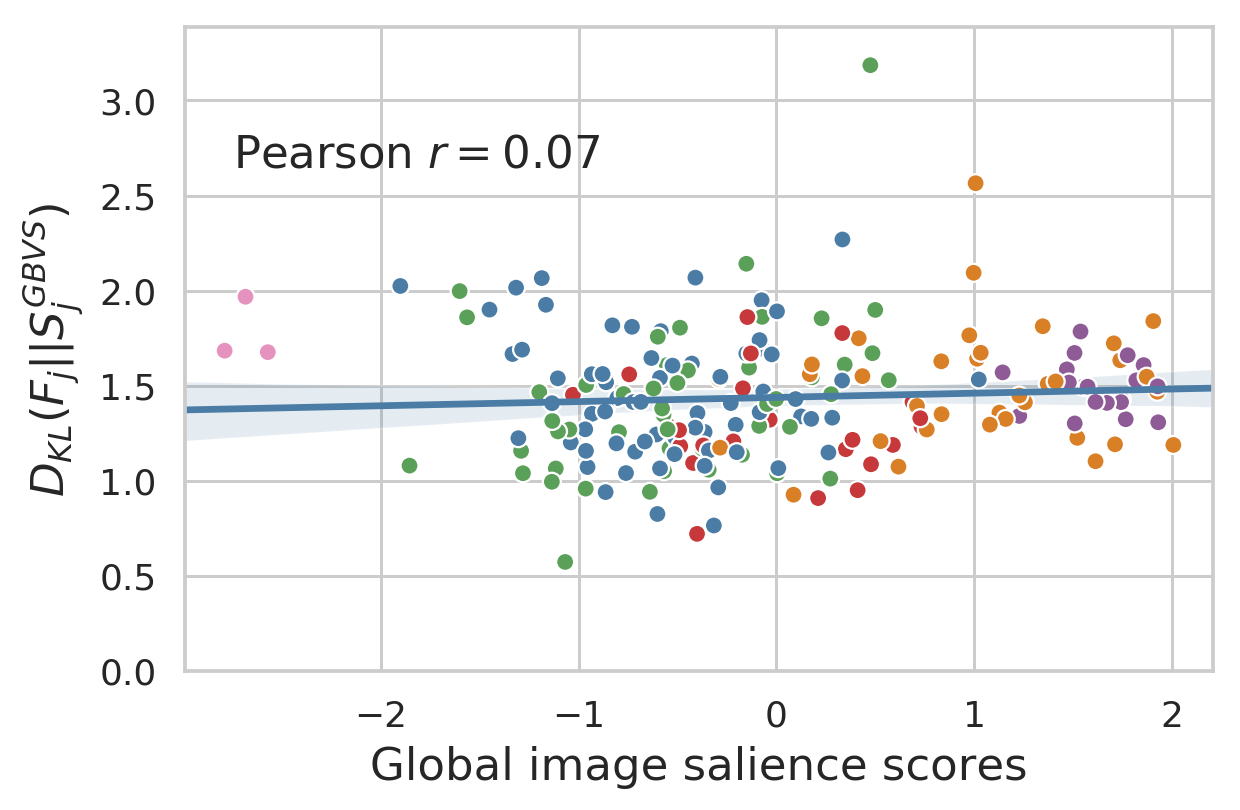]] .right-column[.center[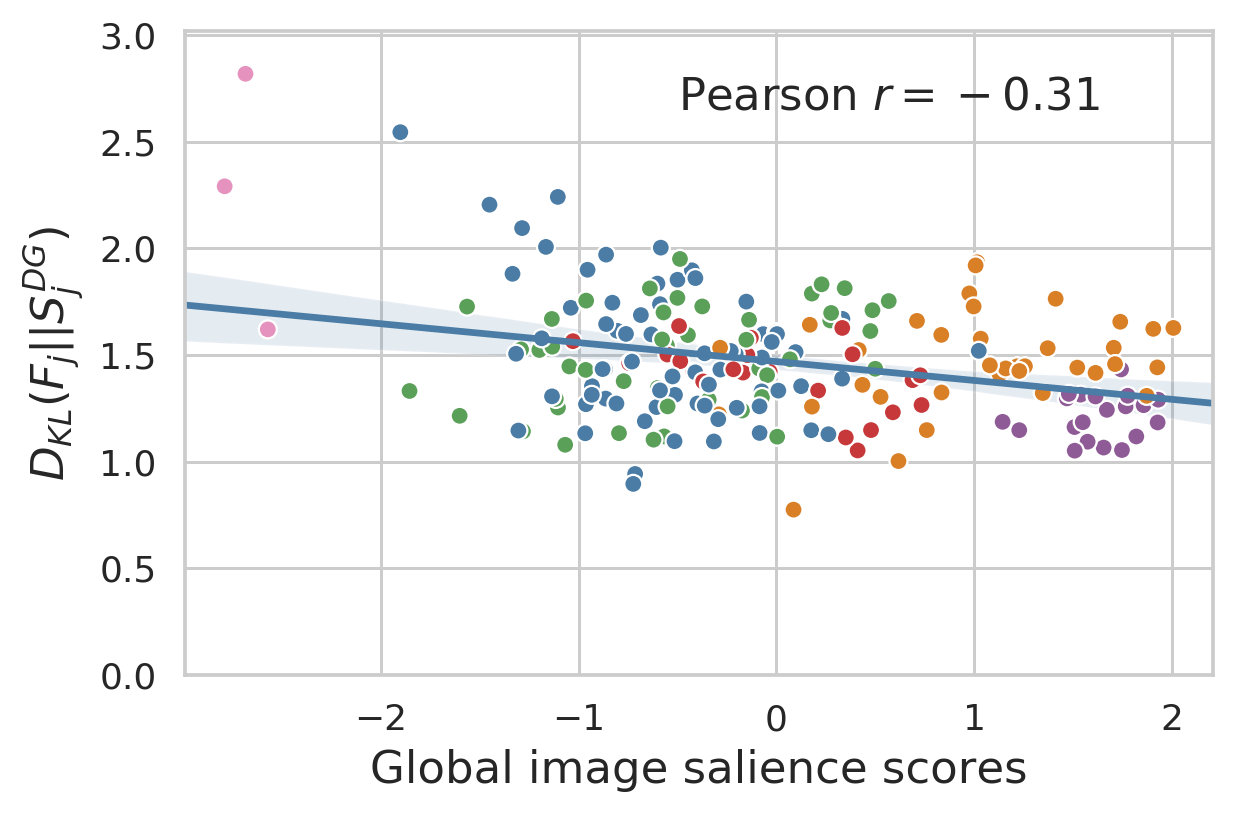]] .full-width[.conclusion[GBVS does not correlate with the global salience, Deep Gaze has low-to-moderate correlation.]] --- ## Results ### c. Lateral bias .context[Previous studies have observed a general lateral bias of visual attention towards the left. Is that the case in our data too?] .center[] * 63 % of all first fixations landed on the left side. * ANOVA: general spatial bias of the initial saccade towards the left ($p < .001$) with no further effects. --- count: falsej ## Results ### c. Lateral bias .context[Previous studies have observed a general lateral bias of visual attention towards the left. Is that the case in our data too?] .left-column[.center[]] .right-column[.center[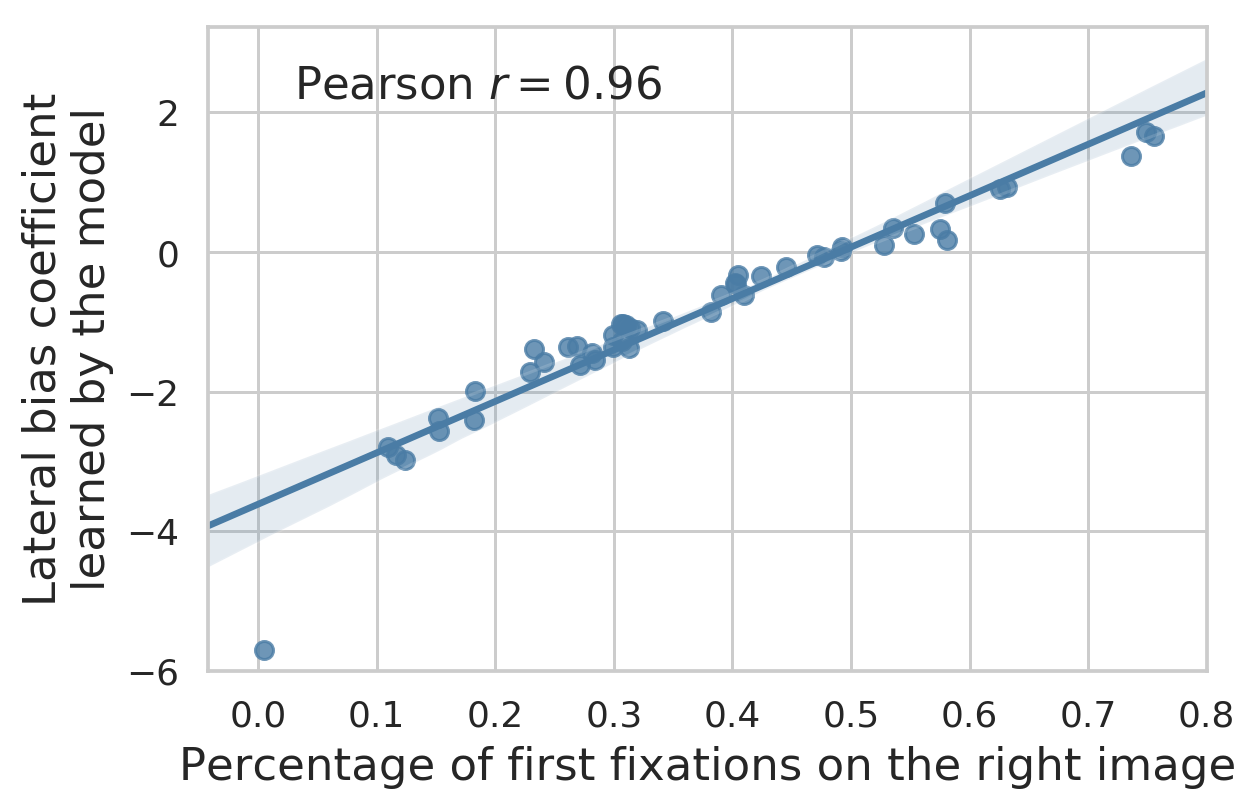]] .full-width[ .alpha0[placeholder] .conclusion[Our results confirm a general spatial bias towards the left, but with high inter-subject variability.] ] --- ## Results ### d. Task and familiarity .context[Do task and familiarity play a role in the direction of the first saccade?] .center[] -- .center[] * Participants correctly identified the new/old images in 91 % of the trials .conclusion[Task and familiarity with one of the images did not influence the direction of the first saccade.] --- ## Results ### e. Exploration (dwell) time .context[Do we also explore longer one of the sides? Or the new images? Or the images with higher global salience?] -- ### Dwell time and laterality .center[] .conclusion[Despite an initial lateral bias, neither the left or the right image were explored significantly longer.] --- ## Results ### e. Exploration (dwell) time .context[Do we also explore longer one of the sides? Or the new images? Or the images with higher global salience?] ### Dwell time and task & familiarity .center[] .conclusion[Participants explored longer the new images, especially if the task was to select the new image.] --- ## Results ### e. Exploration (dwell) time .context[Do we also explore longer one of the sides? Or the new images? Or the images with higher global salience?] ### Dwell time and global salience .left-column[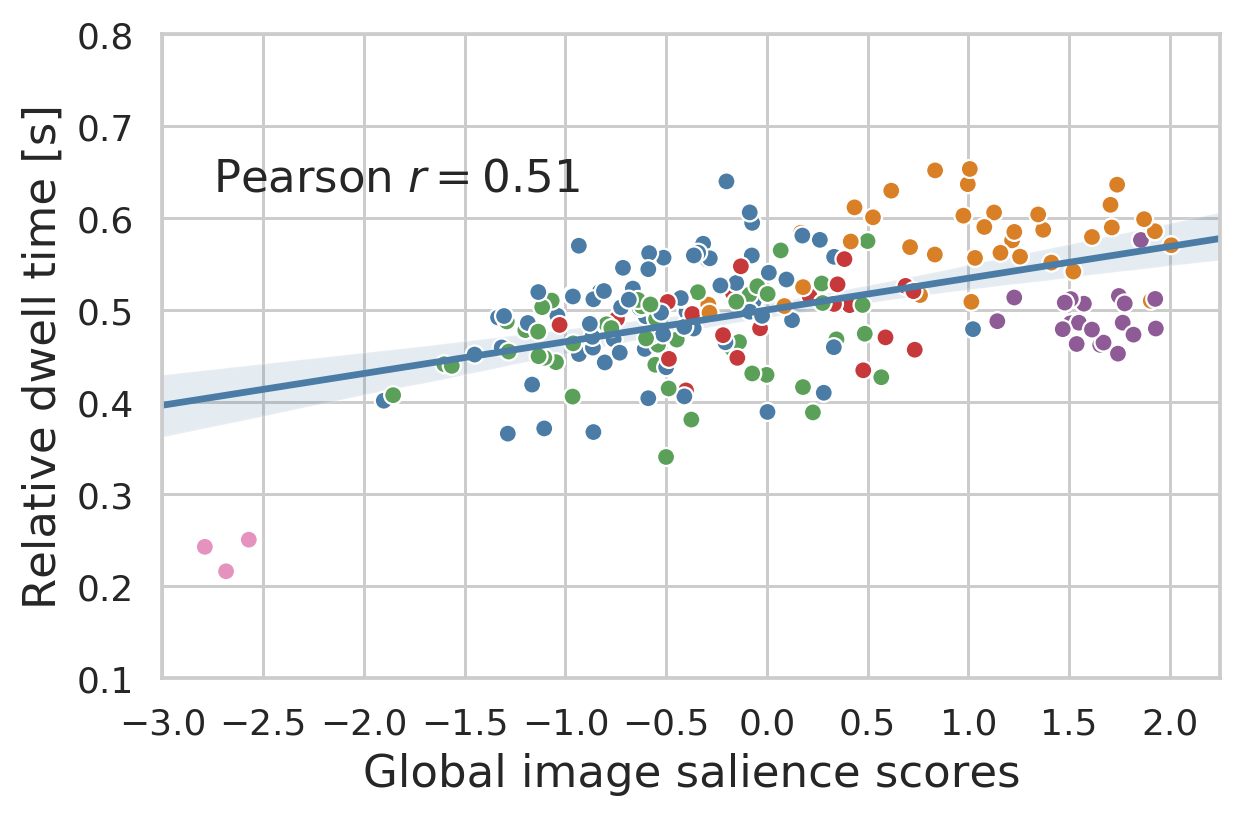] .right-column[.conclusion[There is a moderate correlation between the global salience of images and the exploration time: images that are more likely to be fixated first are also explored longer. One difference: complex scenes with humans are explored for longer. ]] --- ## Summary <img src="../assets/images/slides/globsal/flower_chess_bg.png" style="height: 6em; position: absolute; right: 2em; top: 2em"> .left-column-66[ * Eye-tracking experiment with .highlight1[competing visual stimuli]. * We studied the effect of a light .highlight1[task], the .highlight1[familiarity] with one of the images and the .highlight1[lateral bias]. ] .full-width[.center[]] * We train a machine learning model with the eye-tracking data to obtain .highlight1[global salience scores]. * We compared our proposed global salience with local salience maps. --- ## Conclusions .bigger[ * It is possible to measure the global salience of natural images. * The global salience of images cannot be explained by their local salience properties. * There is a strong spatial towards the left side (unsurprisingly). * Task and familiarity with one image do not influence the first fixation. * Images with larger global salience are explored for longer time. ] --- ## Want to know more? .center[ <a href="https://psyarxiv.com/z7qp5"><img src="../assets/images/slides/globsal/psyarxiv.png" alt="PsyArXiv" style="height: 7em"></a> <a href="https://jov.arvojournals.org/article.aspx?articleid=2770513"><img src="../assets/images/slides/globsal/jov.png" alt="JoV" style="height: 7em"></a> * Code: [github.com/alexhernandezgarcia/global-salience](https://github.com/alexhernandezgarcia/global-salience) * Poster follow-up project: _Temporal saccadic dynamics in free viewing of competing naturalistic images_, by Karla Matić et al - **Poster session 8, Thursday at 19:00 CEST**. ] --- name: title class: title, middle ## Thanks! .bigger[Collaborators: Ricardo Ramos Gameiro & Alessandro Grillini & Peter König] .smaller[Funding: This project has received funding from the European Union’s Horizon 2020 research and innovation programme under the Marie Sklodowska-Curie grant agreement No 641805.] .gray224[European Conference on Visual Perception (ECVP) 2021 · The Internet · August 25th 2021] .center[ <a href="https://mila.quebec/"><img src="../assets/images/slides/logos/mila-beige.png" alt="Mila" style="height: 4em"></a> <a href="https://www.uni-osnabrueck.de/"><img src="../assets/images/slides/logos/uni-osnabrueck.png" alt="Universität Osnabrück" style="height: 4em"></a> <img src="../assets/images/slides/logos/eu.png" alt="European Union" style="height: 4em"> <a href="https://www.nextgenvis.eu/"><img src="../assets/images/slides/logos/ngv.png" alt="NextGenVis" style="height: 4em"></a> ] .footer[[alexhernandezgarcia.github.io](https://alexhernandezgarcia.github.io/) | [alex.hernandez-garcia@mila.quebec](mailto:alex.hernandez-garcia@mila.quebec) | [@alexhdezgcia](https://twitter.com/alexhdezgcia)] [](https://twitter.com/alexhdezgcia) --- ## Questions? <img src="../assets/images/slides/globsal/experiment_scheme.png" style="height: 5em; position: absolute; right: 2em; top: 2em"> <br> <br> .left-column[] .right-column[] .full-width[.center[]] .center[.footer[[alexhernandezgarcia.github.io](https://alexhernandezgarcia.github.io/) | [alex.hernandez-garcia@mila.quebec](mailto:alex.hernandez-garcia@mila.quebec) | [@alexhdezgcia](https://twitter.com/alexhdezgcia)] [](https://twitter.com/alexhdezgcia)]